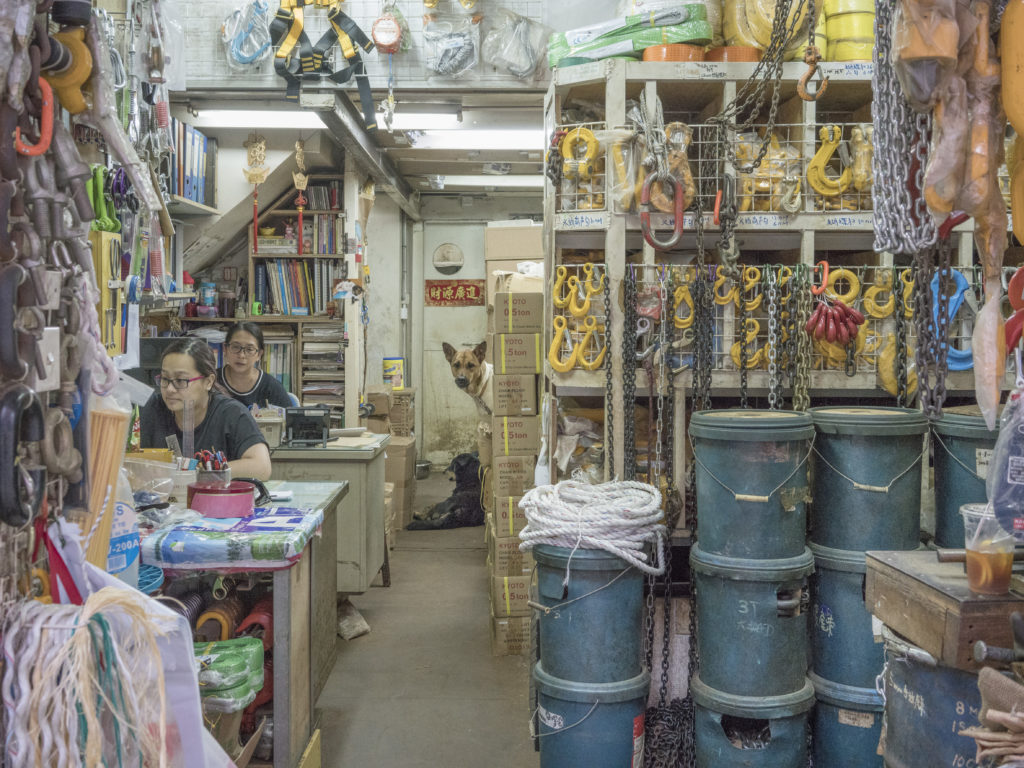Dutch photographer Marcel Heijnen published a photo book on Hong Kong’s shop cats in 2016, and he tells Coconuts HK that after it came out, he received a lot of inquiries about whether or not he was going to follow up with a photo book about dogs.
“I said ‘no, because there are no dogs in shops’,” said Heijnen.
Then, according to Heijnen, he changed his mind about that during a visit to Chai Wan, where the printers for his book are based. On one of his early visits to the printers, he came across a dog named Shu Shu. Shu Shu was sitting in a garage.
Suddenly, a book about Hong Kong’s garage dogs didn’t seem so far-fetched, and the dog that triggered this project now has its portrait gracing the front cover of Heijnen’s latest book, Hong Kong Garage Dogs.


Heijnen’s book, which comes out next month, features 80 photographs of 50 garage dogs, from different parts of the city — namely To Kwa Wan, Tai Wai, Chai Wan, Tai Kok Tsui, Tsuen Wan, and Shau Kei Wan.
Like his last two books about Hong Kong’s shop and market cats, the imagery in HK Garage Dogs contains a lot of textures: greasy exhaust pipes, colorful wires, and waxed car chassis act as backdrops for a lot of these portraits.
But unlike his last two books, this one is noticeably darker, and some of the subjects are — we don’t feel good about saying this — well, simply put, some of them are not what you’d call conventionally cute.

“It’s grease, and dirt, and engines, and guys, and tools,” says Heijnen, adding that the canine subjects in his latest book are “the ying to the shop cats’ yang.”
Heijnen admits that it was a lot more challenging to photograph the canine models for his latest book for two reasons: Garage dogs are harder to find than shop cats, and they also don’t sit still for photos unless they are sleeping.

“[Cats] are usually quite sedate; when they sit in the spot, they’ll just sit there,” he explains. “Especially the shop cats because they’re used to so many things going on, so usually when they sit in a spot, I can take my time and take four or five good shots. But these guys [the dogs], they’re very jittery.”
Heijnen says that part of the reason for that is because the dogs are there to guard the garage. Some of them are a lot more aggressive, some have to wear muzzles, and others are even chained to the shop door.

But even amidst the darkness of the city’s garages and the lack of an obvious “cuteness factor,” Heijnen found some lighter, funnier elements to balance out the darkness.

He also added that like the shop owners from the cat series, garage owners — who Heijnen says normally end up looking after a dog because a son or daughter initially adopted it and left it to their parents to take care of — also have a visibly intense bond with their canine companions.
“The few that we interviewed, they were really proud and loving to their dogs,” he said.

With the garage dogs book in the final phases of proofreading before it goes to print, Heijnen described the project as “a nice little sidestep, especially because people were starting to call me the cat photographer.”
On top of working on this latest book, Heijnen has also been adding the final touches to his exhibition at the Hong Kong Polytechnic University’s School of Design, where he will be displaying photographs from his Chinese Whiskers series, and also some photos from an earlier collection of works he did called Residue, which focuses on textures in the city — peeling paint, rusty metals, and washed up wood.

Although keen to move away from the cat photographer label, Heijnen tells Coconuts that he has been in discussions with publishers in the mainland for a book about the shop cats of China, a project that has taken him to the cities of Beijing, Changsha, Guangzhou, and Shanghai.
Like his previous books, Heijnen says the Chinese version of the shop cats series will use the premise of “photographing the city, but using a cat as the excuse,” to document ancient parts of these cities that are in danger of disappearing because of increasing urbanization.

As we wrapped up the interview, we also got Heijnen to comment on his personal pet preferences. Apparently, he’s a cat person.
Marcel Heijnen’s exhibition Post N̶o̶ Bills will be held at the Hong Kong Polytechnic University’s School of Design, and will run from Thursday, Oct 25 to Friday, Nov 30.
There will be a book launch and calendar launch at G.O.D. PMQ in Sheung Wan at 6pm-8pm on Thursday, Nov 29.





Reader Interactions